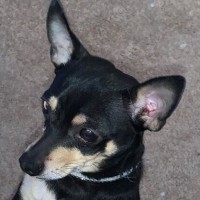Appearance of the Chin-Pin
|
| The Chin-Pin is a cross between a Japanese Spaniel and a Miniature Pinscher. They will adopt many characteristics of the parent breeds, so colors may include black, white, red, tan, rust and chocolate. Their coats are likely to be fine and short, but can be quite silky if they resemble the Japanese Spaniel. Chin-Pins won't need much grooming and they don't shed much. If your Chin-Pin has the facial features of the parent Japanese Spaniel, the eyes will be wide apart, although it is generally found that this hybrid has the head shape and appearance of the Miniature Pinscher, with the beige and black mask. |
Temperament of the Chin-Pin
|
| A Chin-Pin will adopt many traits from their parent breeds, and is therefore likely to be an excellent pet with preferably older children. They are likely to be affectionate and energetic like the Miniature Pinscher, often called Min Pin, and known as the "King of Toys" for its confident attitude. They are very inquisitive dogs, always looking to explore, and skilled enough to close the gap when a door is open. They are fearless and good watchdogs, and dislike strangers. They are best with older children as they are small dogs and can be easily hurt with younger ones. They can be a challenge to train and are prone to chasing other dogs. Your hybrid will also love being with people and will be a happy, playful dog. They are a bit like cats in that they love to climb and groom themselves. Chin-Pins can be trained with positive reinforcement, but keep them on a leash when outdoors as they chase other animals. They don't need much exercise and don't like to be left alone for too long. |
Needs and activities of the Chin-Pin
|
| Your Chin-Pin won't need much exercise to stay happy and healthy, but this will depend on the parent breed it chooses, as Miniature Pinschers need more activity than Japanese Spaniels. This hybrid can become destructive if bored, so regular walks and play sessions will keep him calm. Both parent breeds are excellent for apartment-dwellers, but need to be taken out regularly. Neither parent breed is happy to be left alone for any length of time, so it's best to expect a Chin-Pin that always wants to be by your side. Your pet should be kept on a leash when taken outdoors, as it may chase other animals and hesitate to come when called. Your pet is likely to be sensitive to heat and cold; don't leave them out in extreme weather conditions. |
Maintenance of the Chin-Pin
|
| None of the parent breeds are hypoallergenic, but your dog won't need much grooming to keep a good appearance, and he won't shed much either. Like the parent breeds, your dog is unlikely to need brushing more than once a week. A nice brush with a smoother coat will keep it smooth and shiny. Chin-Pins rarely need a bath, sometimes just a wipe down with a damp cloth if they've been playing outside and are muddy. Try to brush your dog's teeth every day to avoid any dental problems, as small dogs often have teething problems, and check the ears for dirt. Depending on whether your hybrid has a more cheerful ear or a folded set, moisture build-up can be a problem, so be vigilant. |









 English (United Kingdom)
English (United Kingdom)